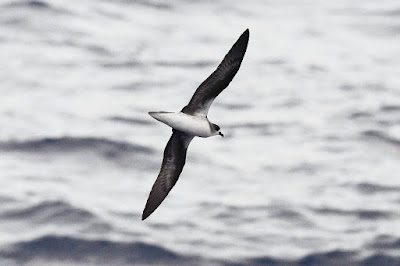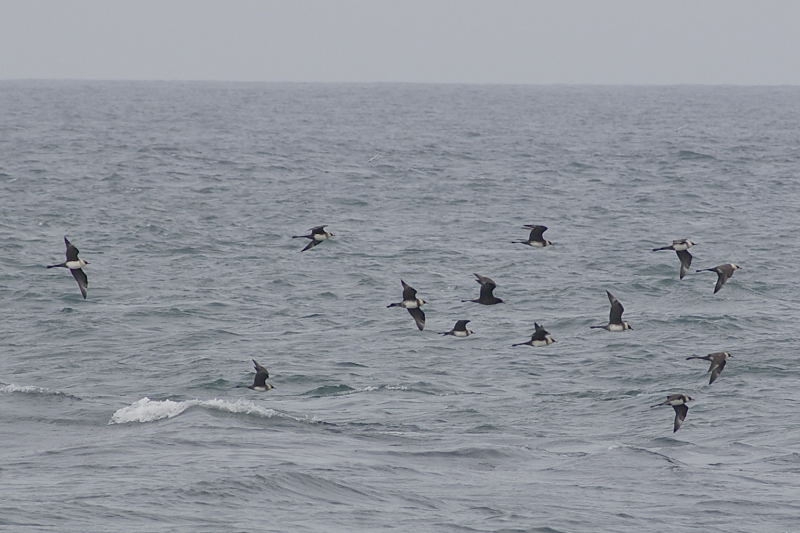We saw the first accepted Pterodroma for Devon pass Prawle Point on 17/08/1999, but in awful weather and far too briefly (c10 seconds) to really appreciate it. We actually submitted as a Pterodroma of the Fea's / Zino's / Soft-plumaged Petrel group, in those days Soft-plumaged Petrel was still being used to describe UK and Irish birds. It was accepted as a Zino’s / Fea’s Petrel - yes back to that in a minute. Despite that bird being too brief for a real ‘knee tremble’; it was still a momentous occasion for the five of us who saw it, which Matt Knott nicely wrote up in DBR1999 p167–168.
My second at Berry Head on 17/07/2001 was a different
experience altogether, much better views, better weather and seen for a longer
period (5 minutes, to appreciate it) with Mike Langman and Bill MacDonald. Mike
and I picked it up simultaneously well to our north in Lyme Bay, with two Manx heading in
towards us. I can still remember suddenly seeing that graceful yet dynamic flight and yes the
‘old’ knees immediately going into the ‘Pterodroma
tremble’. So much so I struggled to get the words out, mumbling “**** you
better get on this”. This bird was clearly bigger (longer-winged) than the
accompanying Manx. One of the reasons we actually submitted as
Fea’s Petrel (based on size etc), but it got accepted as Zino’s / Fea’s Petrel.
Four more followed from visits to Ireland in 2006 and 2007, again each time I
saw one, still that rush of adrenalin. The three Irish birds in 2007 were made
even sweater with the realisation Del and I managed to clock the first, second and
third sightings for County Mayo! Yet each time that real buzz of pure excitement that
just doesn’t go away with the next one. My final UK bird (so far, here’s hoping)
was again at Prawle Point on 31/08/2009, this time on my own and seen for 10
minutes as fairly well out, but picked up coming from well to the east and
continued to watch until is disappeared into the west. It still invoked the ‘Pterodroma tremble’, after which I
rushed up to Prawle village to get a mobile signal to phone it in, hoping to
give others a shot at it further west along the coast. It went past Porthgwarra
right on cue, some 5 hours 21 minutes
later, giving those present a chance to appreciate the ‘Pterodroma tremble’, or as Russ Wynn there at the time described as ‘dribbling and swearing’. I suppose they have different effects on different
people! What also makes these birds so magic on a seawatch is, they just
don’t hang about and after that brief view (a few minutes if you’re really
lucky), they’re gone and you’re left wanting more, or thinking did I really see
that!
Well a few years have passed and I’ve not been lucky with
another off Devon or even trips to Cornwall. I felt myself going into some sort
of Pterodroma withdrawal (well save
the one we’ll visit in a minute). There was only one remedy, I just had to go to
Madeira and indulge myself in the Wind
Birds pelagic trips, following in the footsteps of seawatching friend, the late Dave Norman and so many others. I’d heard so much good talk about these trips, with the added
possibility of seeing both Zino’s and Fea’s (Desertas) Petrels. Definitely on a
seabirders must do list!
So I completed the Wind
Birds amazing three days of pelagics during 26/05/15–28/05/2015. I had
great views of many tubenoses, including seeing three new species. But you know
what, for me the best were those Pterodroma
sightings (and White-faced Storm-petrel of course). Even out on a boat you get
that absolute buzz when one turns up, usually just all too briefly as it
investigates the chum slick before just disappearing again back out into the
ocean. It was great to actually see Zino’s Petrel in the field and although I
should have taken a lot more photos, I preferred to watch and savour when one
turned up, rather than having my eye buried in the back of a DSLR all the time and missing
the action. Although we saw Pterodroma petrels
that could not be specifically assigned to either Zino’s or Fea’s (Desertas)
Petrels, I found both the ‘good’ Zino’s we saw to be more delicate birds than the
‘good’ Fea’s, with a lighter feel about them and how they flew, being
more Manx sized - even before critical stuff like bill size (and underwing) was analysed from
photos. Now thinking back to my few UK and Ireland sightings, though they’ve
all been accepted as Zino's / Fea’s, not one of them (based on my Madeira experiences) could I say best fitted
Zino’s. Those seen well and in company of other seabirds for size comparison
have all better fitted Fea’s. When you think the few positively identified birds
so far off the UK (all photographed) have been Fea’s, Zino’s does seem to be the less likely
(especially considering relative population sizes), although as with all seabirds anything is possible, as a Bermuda Petrel off Ireland and Soft-plumaged Petrel off Norway show. But heck in bird reports with this particular species amalgam the Zino's bit comes first (taxonomic order!), Zino's / Fea's. It’s a bit like seeing
Cory’s Shearwaters off Devon, there’s a remote possibility we may overlook a
Scopoli’s Shearwater (and we’d need a good photograph to get one accepted), but we’re
still calling them Cory’s Shearwater (and in the bird reports) as the most likely and not Cory’s / Scopoli’s Shearwater. Of course many of the
Cory’s I’ve seen off Devon were sufficiently good views of the underwing to be
fairly confident they were Cory’s, but many weren't (but separable from Great of course). Anyway going back
to main subject, a Pterodroma sighting
is still a magic event whether you can go down to species or not.
That brings me onto one that got away. On the 02/10/2012 I was at my favourite Devon seawatch headland. Conditions were ideal with a SSW 5, increasing SW force 6–7 and murky horizon. There was an exceptional Sooty Shearwater passage underway; I ended the day with 326 birds - Devon's second highest count (also 82 Balearic Shearwaters). An excellent watch in itself, however, at 10:15 I saw a bird that completely stumped me at the time. It was a fair way out, moving through with Sooty Shearwaters, so in direct comparison very similar in size. When I initially picked it up I thought I was looking at a slim dark phase skua (like a dark juv Long-tailed in shearing flight). I've seen Long-tailed shearing before many times (including many trips watching the passage off North Uist), but then the flight of this bird was far more dynamic and not a skua! That initial thought of skua was because the bird was a cold dark brown and lacked the silvery underwing (though the coverts) of Sooty Shearwaters (many for comparison), any pale on the underwing was restricted to just the base to the primaries (underwing), it also lacked the longer necked, smaller headed look of Sooty, being shorter necked and slightly larger headed. The similarity of the attenuated rear end of Long-tailed skua, almost a wedge-tailed appearance was also notable! The more I looked at it the more I was convinced it was a dark Pterodroma sp. That effortless flight, several times it towered up (yes Sooties do that), but with little effort and hardly a flap looking more buoyant, to be easily lost on the down glide against the sea to reappear again towering up. At one point it looped completely back on its flight path in typical Pterodroma fashion. At this point I went into the ‘Pterodroma tremble’ and after it had gone I gathered my thoughts made some notes and phoned fellow seawatching friend Mike Langman. I was certain it was not a Sooty (I’d seen a quite a few) and not a skua. I knew it was something very good, but I also knew realistically I wasn’t likely to ever do anything with it (too far out for a photo which you will need for an extreme rarity) - but what was it likely to be? In early 2013 I purchased Steve Howell's (then new) ‘Petrels, Albatrosses, and Storm-Petrels of North America: A Photographic Guide’. In this excellent book I found something that matched my bird. Pictures and description of dark morph Trindade Petrel! I also hadn't realised they were regularly occurring in the west North Atlantic!! Later in 2013 I also purchased Bob Flood and Ashely Fisher’s superb ‘Pterodroma Petrels’ multimedia guide. Again Trindade Petrel was the best fit. So I bucked up the courage to email Bob about the sighting, saying not enough to go any further but what were his thoughts? I received a very positive reply, which concluded this was the most likely candidate, as fairly regularly occurring off North Carolina (and a few Azores) and to date c. 70% in the North Atlantic have been dark morph! He went on to say “When I read your description of 'that bird' off Start Point, it resonated strongly with my experiences of Trindade Petrel”!
Had somehow a Trindade Petrel go caught up in the same Atlantic conditions that had brought in this massive movement of Sooties to the Western Channel? Of course I'll never know!
But alas for me a Pterodroma that got away. Seems the UK has had a few close calls with this particular “knee trembler”, I hope one will be seen well (and photographed) sooner or later and added to the British list!
 |
| Notes on that bird. I'm no bird artist, looks like I've drawn a skua, but it weren't no skua! |















